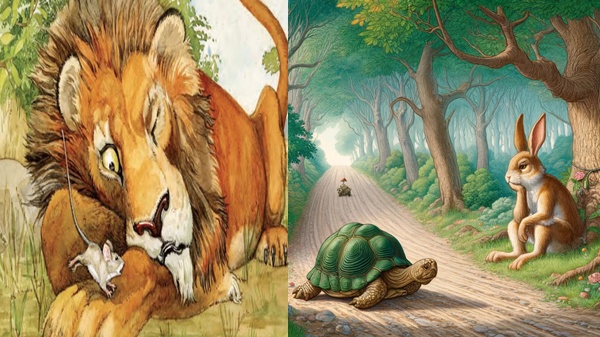Fables
Fables [250 Words]
A fable is a short, fictional story that aims to convey a moral lesson. Fables often feature animals, objects, or forces of nature as characters, which are anthropomorphized, meaning they are given human qualities. These tales are designed to teach ethical principles and impart wisdom. Famous fable examples include Aesop’s “The Tortoise and the Hare” and “The Boy Who Cried Wolf.” The moral or lesson of the story is usually explicitly stated at the end to ensure the message is clear. Fables have a rich and diverse history that spans across cultures and millennia. The earliest recorded fables come from ancient Greece, with Aesop often cited as the first known fabulist. Aesop was a slave and a storyteller who lived in ancient Greece between 620 and 564 BC. His fables, such as The Fox and the Grapes and The Tortoise and the Hare, have become timeless classics that continue to teach moral lessons to children and adults alike. Fables found their way to other parts of the world as well, including Africa, where oral tradition allowed these stories to be passed down through generations. Here, they often took the form of trickster tales featuring clever animals outsmarting their foes. In essence, the history of fables is intertwined with the history of human society itself, reflecting our shared desire to make sense of the world around us and impart wisdom through engaging stories. From ancient Greece to modern-day children’s books and animated films, fables have proven their enduring appeal and relevance throughout time and across cultures.
Or, [350 Words]
Fables are short fictional stories that teach moral lessons, often using animals, plants, or inanimate objects as characters. These characters are given human traits like speaking, reasoning, and behaving like people. The primary purpose of a fable is to convey a moral or a lesson in a simple and understandable way. This makes fables particularly popular among children, though their messages are timeless and relevant to people of all ages. One of the most famous contributors to this genre is Aesop, a storyteller from ancient Greece, whose fables such as The Tortoise and the Hare, The Fox and the Grapes, and The Ant and the Grasshopper continue to be widely read and taught around the world. These stories often highlight values such as honesty, kindness, hard work, patience, and wisdom, while warning against negative traits like greed, laziness, or pride. Fables are usually very brief, yet powerful. They use simple language and often end with a clear moral or proverb, making them easy to remember and share. Because they involve animals and imaginative situations, fables also captivate the reader’s interest while delivering meaningful insights into human behavior and society. Many cultures have their own traditions of fables. For instance, the Panchatantra from India, the Jataka tales from Buddhist literature, and the stories of La Fontaine from France are all collections of fables with strong moral teachings. In today’s world, fables remain important in both education and storytelling. Teachers use them to install values in students, and parents often tell fables to children as bedtime stories. Even in modern media like cartoons and children’s books, the essence of fables can be seen. Overall, fables are a powerful and timeless tool for teaching life lessons in a way that is entertaining, memorable, and easy to understand. Their universal appeal and moral strength ensure that they will continue to influence generations to come.

